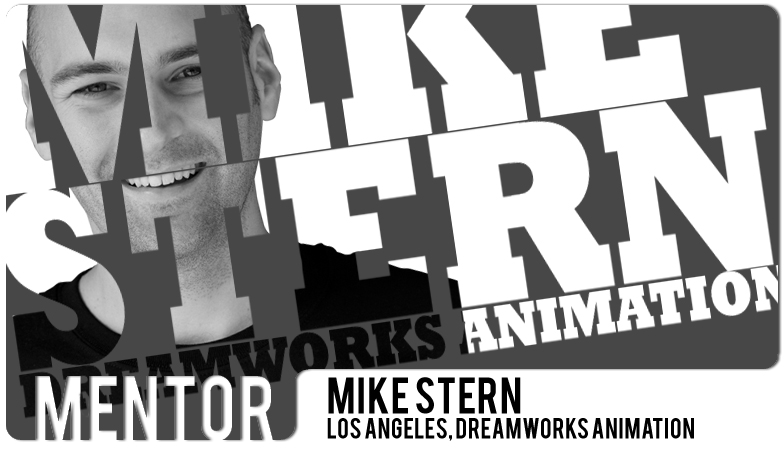Featured Mentor Mike Stern
Animator at DreamWorks Animation, Burbank, CA
Animation Mentor:
What inspired you to learn character animation?
Mike Stern:
I grew up watching animation and working with computers. When I saw that those two worlds were starting to collide, I did everything that I could to make sure that I was a part of it.
Animation Mentor:
What were the most important steps in your animation training?
Mike Stern:
I started out as a 3D generalist. Deciding to specialize in character animation was an important step.
There were also a couple of key moments in my animation training where I felt that I turned a corner. A good example would be when I began to understand the importance of context in a shot.
It was at that point where I stopped trying to simply imitate the type of animation that I saw on reelsand started to think about each shot as part of a story.
Animation Mentor:
If you could do one thing differently on your journey to becoming an animator, what would it be?
Mike Stern:
I think the one thing I would do differently is to pace myself. Patience is not something that you hear many people talk about when it comes to animation training. My biggest failures were the result of trying to do too much too soon or juggle too many things at once.
Animation Mentor:
Where do you currently work and what are the projects you've worked on in the past?
Mike Stern:
I am currently working as an animator at DreamWorks Animation. I just wrapped animation on How to Train Your Dragon and I am currently working on Puss in Boots.
Prior to these two films I worked as an animator on Monsters vs. Aliens, Kung Fu Panda and as a cycles animator on Bee Movie.
Animation Mentor:
Who is your favorite character that you've animated?
Mike Stern:
I loved the characters that I worked with on How to Train Your Dragon. Animating Toothless was extremely challenging. He had more controls than any rig that I had worked with before, and his character was constantly evolving.
When I animated shots of him towards the start of the film we were very focused on his locomotion. Each shot was a new experiment to see how he would move and fly. As the film production progressed we became more focused on getting his personality into each and every shot.
I also really liked working on Astrid. We portrayed her as a tough character and I was lucky to be able to work on some of her sweeter moments.
Animation Mentor:
What was your first animation job?
Mike Stern:
I did some basic flash animation and motion graphics work when I worked in the advertising industry. My first character animation job was an internship at Shaba Games in San Francisco.
Animation Mentor:
Who would you consider your mentor to be in animation?
Mike Stern:
It would be tough to narrow it down to one person because there are so many people that have influenced me as an animator.
Most recently, on How To Train Your Dragon, I got a lot of support from the head of animation Simon Otto. He and the character supervisors Gabe Hordos, Shaggy Hornby and Jakob Jensen really pushed me to do my best work.
I also get a lot of help from my peers on a daily basis.
Animation Mentor:
What do you enjoy the most about teaching at Animation Mentor?
Mike Stern:
The thing I enjoy the most is seeing student turn a corner during my class. There are usually about one or two each term that come in with average work, but at some point something clicks and their work takes off.
Animation Mentor:
How is Animation Mentor different?
Mike Stern:
I think the big difference is that the teachers are all working professionals. The instruction given in this school has been tested at the highest levels.
I think that you need to be in the practice of animating to be a good animation instructor.
Animation Mentor:
What is the most rewarding part of having a career in animation?
Mike Stern:
I think the biggest reward is experiencing an audience's response to your work.
You can spend upwards of a year working on something that the general public knows little to nothing about. Then all of the sudden it's everywhere you look.
Animation Mentor:
How do you stay current as an animator?
Mike Stern:
I certainly watch a ton of movies, new and old, whatever I can get my hands on. I also try to keep my head buried in a couple of books on drawing, photography, story structure or animation.
I do read a lot about animation on blogs, and listen to podcasts, but I also try to keep those things at an arms distance.
There are some pretty strong opinions out there and I think it's important not to let those opinions replace your own sensibilities.The animation community can be a bit of a bubble and I think the best way to stay fresh is to constantly bring things in from the outside.

